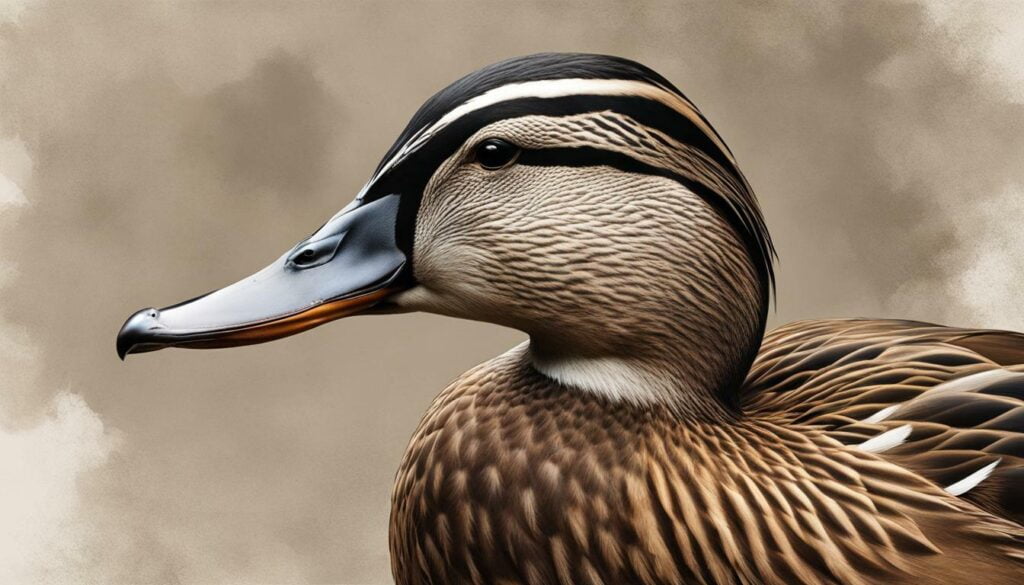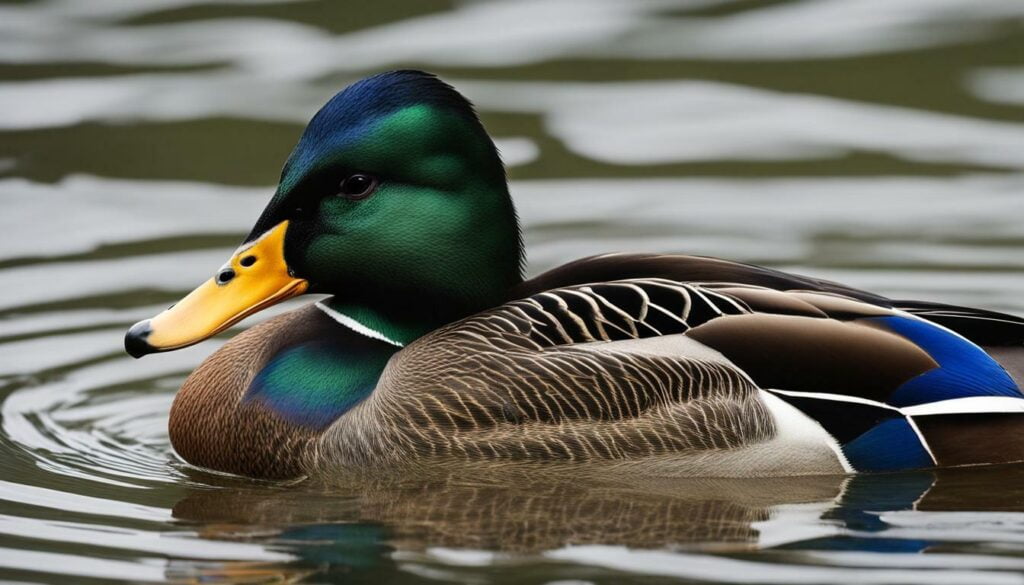Greetings readers! Today, we embark on an exciting journey to explore the hidden world of ducks’ ears. Have you ever wondered where they are located? Join me as we uncover the secrets of duck ear anatomy and reveal some fascinating facts along the way.
Contrary to what you might expect, ducks’ ears are not visible like ours. They are small openings situated on the sides of their heads, tucked away behind and below their eyes, and charmingly concealed by feathers. It’s like a secret hideout for their auditory system!
Ducks, being the savvy navigators they are, use their entire head as ears. This unique adaptation allows them to hear sounds from all directions – above, below, and on the same level. It’s like having surround sound for ducks! They rely on their acute sense of hearing to find their way around, communicate with fellow ducks, and even locate delicious food.
But wait, there’s more! Did you know that ducks can mimic sounds they hear? Yes, it’s true! They can imitate various noises, from car doors slamming to the soothing melodies of their feathered friends. It’s their secret talent that adds a touch of whimsy to their already delightful repertoire.
Not only do ducks’ ears enhance their communication and navigation skills, but they also play a crucial role in regulating body temperature. These remarkable creatures have adapted to their surroundings, and their ears contribute to their overall thermal management. It’s truly a marvel of nature!
So, let’s embark on this auditory adventure together and unravel the mysteries of duck ear anatomy. By understanding their unique features, we gain a deeper appreciation for how ducks have adapted to thrive in their natural habitat.
Join me in the next section as we discuss whether ducks have ears or not. Prepare to be amazed! But before we dive in, take a moment to feast your eyes on the captivating image below that perfectly captures the essence of our topic.
Key Takeaways:
- Ducks’ ears are not visible and are located behind and below their eyes.
- They use their entire head as ears, allowing them to hear sounds from all directions.
- Ducks can mimic sounds they hear, adding a delightful touch to their repertoire.
- Their ears also help regulate their body temperature.
- Understanding duck ear anatomy sheds light on their remarkable adaptations for survival.
Do Ducks Have Ears? Understanding Duck Ear Anatomy
When we think of ears, we often imagine them as visible structures on the sides of our heads. However, ducks have a unique ear anatomy that is quite different from ours. While their ears are not visible, they do indeed have them.
Ducks’ ears are small openings located on the sides of their heads, behind and below their eyes. These openings are covered by feathers, making them difficult to spot. Instead of having external ear structures like humans, ducks use their entire head as ears.
This design allows ducks to hear sounds from all directions, including above, below, and on the same level as them. Their sense of hearing plays a crucial role in their everyday lives. Ducks rely on their hearing to navigate their surroundings, communicate with other ducks, and locate food sources.
One fascinating aspect of duck hearing is their ability to mimic sounds they hear. For example, if a duck hears a car door slamming, it can imitate that sound. This unique talent adds to the playful and engaging nature of ducks.

Ducks’ ears are strategically positioned to optimize their hearing capabilities. They are located behind and below the eyes, allowing them to detect sounds while keeping their eyes focused on their surroundings. The feathers that cover their ears provide some protection from water and other elements.
It’s important to note that while ducks’ ears are well-adapted for their aquatic lifestyle, they can be vulnerable to damage from entanglement or forceful water entry. Ducks rely on their ears for survival, so it’s crucial to protect their delicate auditory organs.
In summary, while ducks’ ears may not be visible like ours, they play a vital role in their lives. Their unique ear anatomy and placement allow them to hear sounds from all directions, navigate their environment, and communicate with other ducks. Understanding the fascinating world of duck ear anatomy provides insights into their remarkable adaptations for survival in their natural habitat.
Where Are Duck Ears Located? Exploring Duck Ear Placement
Curious about where ducks’ ears are located? Well, you won’t find any visible ears like ours on these fascinating birds. Ducks have small openings on the sides of their heads, positioned behind and below their eyes, and covered by feathers. These inconspicuous openings serve as their ears, enabling them to hear sounds from all directions.
Ducks rely heavily on their sense of hearing to navigate their surroundings, communicate with other ducks, and locate food. Their unique ear placement allows them to hear sounds both above and below the water’s surface, as well as on the same level as them, enhancing their ability to detect potential predators or prey.
While ducks’ ears are not easily visible, they play a crucial role in their daily lives. These auditory organs are well-adapted for their aquatic lifestyle, aiding in their survival. However, they can be susceptible to damage if the ducks become entangled or experience forceful water entry, highlighting the delicate nature of their ear structure.
| Duck Ear Placement | Function |
|---|---|
| Located on the sides, behind and below the eyes | Allows ducks to hear sounds from all directions |
| Covered by feathers | Protects the ears from water and debris |
| Enables hearing above, below, and on the same level as the duck | Enhances navigation, communication, and foraging abilities |
Understanding the anatomy and function of duck ears provides a fascinating glimpse into their remarkable adaptations for survival in their natural habitat. So, the next time you spot a duck gliding gracefully on the water, remember that hidden beneath those feathers are ears that enable it to thrive in its watery world.

- Nature Society: The Hidden World of Duck Ears
- Duck Research Institute: Anatomy and Function of Duck Ears
- Feathered Friends: The Fascinating Ears of Ducks
How Do Ducks Hear? Unraveling the Duck Hearing Mechanism
Ducks are well-known for their quacking sounds, but have you ever wondered how they actually hear? Let’s dive into the fascinating world of duck hearing and discover the secrets behind their remarkable auditory system.
Unlike humans, ducks don’t have visible ears on the sides of their heads. Instead, their ears are small openings located on the sides of their heads, behind and below their eyes. These openings are covered by feathers, making them virtually invisible to the naked eye. Ducks use their entire head as ears, allowing them to hear sounds from all directions – above, below, and on the same level as them.
So, how do ducks use their remarkable hearing abilities? Their acute sense of hearing helps them navigate their surroundings, communicate with other ducks, and locate food sources. They can even mimic sounds they hear, such as car doors slamming or other duck calls. It’s truly astonishing how adaptable their auditory system is!
Ducks’ ears also play a crucial role in regulating their body temperature. Just like how humans sweat, ducks release heat through their ear openings. This helps them cool down when the weather is hot or when they’re engaged in vigorous activities. It’s yet another amazing adaptation that contributes to their survival in their natural habitat.

In conclusion, understanding how ducks hear offers a glimpse into their extraordinary adaptations. Their hidden ears, combined with their ability to detect sounds from all directions, make them highly perceptive creatures. So, the next time you spot a duck and hear its quack, remember the incredible hearing mechanism that allows them to experience the world in a way we can only imagine.
The Function of Ducks’ Ears: Beyond Hearing
Ducks are fascinating creatures with unique adaptations that allow them to thrive in their natural habitats. While many people know that ducks have ears, the function of their ears goes beyond just hearing. In fact, their ears play a crucial role in regulating their body temperature, among other functions.
Unlike human ears that are visible on the sides of our heads, duck ears are small openings located on the sides of their heads, behind and below their eyes. These ear openings are covered by feathers, making them less noticeable. Ducks use their entire head as ears, enabling them to hear sounds from all directions – above, below, and on the same level as them.
But how do their ears help regulate their body temperature? Well, ducks have a specialized adaptation called the rete mirabile, which is a network of blood vessels located near their ear openings. This network helps regulate the blood flow and temperature in their heads. By adjusting the blood flow to their ears, ducks can keep their heads cool in hot weather or warm in cold weather.
Additionally, the feathers that cover their ear openings act as insulation, further contributing to their temperature regulation. These feathers help prevent heat loss from their heads during colder temperatures and protect their ears from the elements.
Understanding the function of ducks’ ears not only gives us insight into their fascinating adaptations but also highlights the importance of these small openings in their overall survival. Ducks’ ears are much more than just organs for hearing; they are integral to their ability to navigate their surroundings and maintain their body temperature in various environmental conditions.
| The Function of Ducks’ Ears | Regulating Body Temperature |
|---|---|
| Location | On the sides of their heads, behind and below their eyes |
| Function | Hearing sounds from all directions |
| Temperature Regulation | Specialized blood vessel network (rete mirabile) and insulating feathers |

As we admire the beauty of ducks gliding through the water, let’s not forget the hidden marvels of their ears. These small openings serve a vital purpose in the lives of ducks, allowing them to continue their remarkable journey through their aquatic habitats. So the next time you encounter a duck, take a moment to appreciate the intricate functionality of their ears and the extraordinary adaptations that help them conquer their watery world.
Can Ducks Hear Well? Understanding Duck Hearing Abilities
When it comes to hearing, ducks are remarkably talented creatures. While their ears are not visible like ours, they do have small openings located on the sides of their heads, hidden behind their feathers. These auditory organs play a crucial role in their daily lives, allowing them to navigate their surroundings, communicate with other ducks, and locate food.
Unlike humans, ducks use their entire head as ears. This unique adaptation enables them to hear sounds not only on the same level as them but also above and below. Their exceptional hearing abilities even allow them to mimic sounds they hear, such as the slamming of car doors. It’s truly fascinating how they can accurately reproduce the sounds of their environment.
But hearing is not the only function of ducks’ ears. These remarkable organs also play a role in regulating their body temperature. By adjusting the blood flow to their ears, ducks can cool down or warm up their bodies as needed. This is particularly important as they navigate the ever-changing temperatures of their aquatic habitat.

While ducks’ ears are well-adapted for their aquatic lifestyle, they can be vulnerable to damage from entanglement or forceful water entry. It’s important for us to appreciate the remarkable anatomy and function of their ears and understand how they contribute to their survival in their natural habitat. For ducks, hearing is not just a sense, but a vital tool for thriving in their environment.
| Duck Hearing Abilities | Benefits |
|---|---|
| Accurate sound localization | Allows ducks to pinpoint the source of sounds, helping them detect predators and find food. |
| Mimicking sounds | Ducks can reproduce sounds they hear, enabling them to communicate with other ducks and adapt to their environment. |
| Regulating body temperature | The blood flow to their ears helps ducks manage their body temperature in different weather conditions. |
| Enhanced auditory senses | Ducks have evolved to have excellent hearing abilities, allowing them to adapt and survive in their natural habitat. |
Conclusion
From their impressive sound localization skills to their ability to mimic sounds, ducks’ hearing abilities are truly remarkable. Their ears, although hidden beneath their feathers, play a vital role in their survival and enable them to thrive in their aquatic lifestyle. Understanding and appreciating the unique anatomy and function of duck ears not only expands our knowledge of these fascinating creatures but also deepens our appreciation for the diversity of life in our natural world.
Ducks’ Ears and Adaptations for Survival
Did you know that ducks have ears? Although not visible like human ears, ducks’ ears are small openings located on the sides of their heads, behind and below their eyes. These ear openings are covered by feathers, making them difficult to spot. In fact, ducks use their entire head as ears! This unique adaptation allows them to hear sounds above, below, and on the same level as them.
Ducks rely heavily on their sense of hearing to navigate their surroundings, communicate with other ducks, and find food. Their remarkable auditory system enables them to detect and locate sounds with precision. Ducks can even mimic sounds they hear, adding an element of playfulness to their interactions. Have you ever heard a duck that sounds like a car door slamming? Now you know where they get their inspiration!
Aside from hearing, ducks’ ears also play a role in regulating their body temperature. When ducks dip their heads in water, the feathers covering their ear openings help prevent water from entering and cooling their internal body temperature. This adaptation is essential for their survival, especially in colder environments where maintaining body heat is crucial.
While ducks’ ears are well-adapted to their aquatic lifestyle, they can be vulnerable to damage. Entanglement in debris or forceful entry into water can result in ear injuries for ducks. Understanding the anatomy and function of a duck’s ears sheds light on their remarkable adaptations for survival in their natural habitat, and reminds us of the importance of preserving their environment for future generations to enjoy.
FAQ
Do ducks have ears?
Yes, ducks do have ears. Although they are not visible like human ears, ducks have small openings located on the sides of their heads, behind and below their eyes. These openings are covered by feathers and serve as their ears.
Where are duck ears located?
Duck ears are located on the sides of their heads, behind and below their eyes. They are small openings covered by feathers.
How do ducks hear?
Ducks use their entire head as ears, allowing them to hear sounds above, below, and on the same level as them. Their ears play a crucial role in helping them navigate their surroundings, communicate with other ducks, and find food.
What is the function of ducks’ ears?
Beyond hearing, ducks’ ears also play a role in regulating their body temperature. Their unique ear structure helps them maintain their ideal temperature in various environments.
Can ducks hear well?
Ducks have excellent hearing abilities. They rely on their sense of hearing to detect sounds in their environment and can even mimic sounds they hear, such as car doors slamming.
How do duck ears contribute to their survival?
Understanding the anatomy and function of duck ears sheds light on their remarkable adaptations for survival. Their ears help them navigate their surroundings, communicate with other ducks, find food, and regulate their body temperature, all essential for their survival in their natural habitat.

